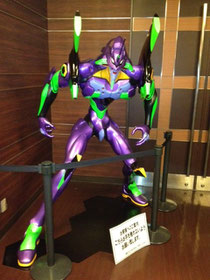I went to buy tickets for Evangelion 3.0 on Saturday around 3:00. They were sold out until Sunday at 9:30. I finally posted my review on IMDB.com, reproduced below.
The Bland of Evangelion

The first two “rebuilds” of Evangelion crammed twenty episodes of the 1995 Shin Seiki Evangelion TV series into a span of three and a half hours, upping the musical and animation ante every explosive step of the way. Three years later, Evangelion 3.0 showed such promise: A teaser trailer so confident that it revealed only the internal workings of a piano; previews of an eyepatched Asuka spiraling through space with a shield and massive rifle to soul-rousing operatic strains. Yet after all the fervent build-up, Eva 3.0 feels like one of those reboots where a project was taken over by people who never understood why the franchise had rabid fans in the first place. Creator Hideaki Anno is still at the helm—and even back in the director’s chair—yet when the film is over, the subtitle “You Can (Not) Redo” feels, more than anything, like an apology.
Anno opens with Asuka and Mari deploying multi-stage booster rockets, high-powered sniper rifles, massive shields and a brand-new pink Eva to fight off an Angel while retrieving Shinji and Unit 01 from Earth orbit. The sequence is brilliant, operatic, even tear-inducing: Then Shinji wakes up in yet another intensive care unit and the roller-coaster ride crashes straight into a ditch from which it will never emerge.
In 1997’s the End of Evangelion, Shinji was offered a world in which he could merge with all of humanity so that he would never again have to feel alone. In Eva 3.0, he is offered a different world—one in which no demands are made of him at all. Enter ninety minutes of nothing.
This is not like what Anno did when he ran out of budget for the animated series, when he drove fans berserk by throwing out all the robot rumbles to dive into the characters’ psyches for the last two episodes. Eva 1995 was all about the characters, putting broken human beings in a world-on-the-brink environment with the idea that their most intense struggles would still be to be loved, cherished, and accepted for who they were. Eva 3.0 strips away both the characters and the environmental crucible, even eliminating the deeper question of why everything is happening, and leaves us only with the hum-drum intellectual exercise of finding out what happened.
Shinji awakes into what is essentially the set of Das Boot melded with the bridge of the Macross. Misato is captain of a giant whale-like flying ark called the Wunder, the Nerv command crew man her bridge, and the cast is rounded out by a trio of space opera stock characters who get more lines than all the old cast combined. Even Mari, who had ‘dark impending purpose’ written all over her introduction in Eva 2.0, turns out to be nothing more than Asuka’s sharp-shooting, one-liner-dropping sidekick. And despite the Third Impact having begun just to save her, when we finally meet Rei, she has no memory of the event and no connection to Shinji—or anyone else—whatsoever.

It turns out that the Third Impact was aborted part-way, and Shinji has been fitted with a Battle Royale-style choker designed to pop off his head if he shows any sign of becoming a deity again. While for a time it seems that we have been immersed in an alternate-universe Eva redesigned as a space opera, it is actually fourteen years later, and all the character dynamics that brought fans to the series have withered and died away. Rei, Asuka and Misato speak so little it’s as if they aren’t even there, and even Shinji doesn’t wallow in self-pity; he is confused by all the changes, but with all the characters so different, the emotional boil we would normally expect to see at this stage of the series simply cannot emerge.
Having achieved friendship and affection in Eva 2.0, Shinji is much better adjusted than in his television iteration, and when he is whisked away from the Wunder to meet Kaworu, he’s not desperate for approval—he just wants to know what’s going on. Separated from all the people who cared about him, Shinji wanders through the hollowed-out remains of Nerv headquarters playing piano with Kaworu, stacking books for Rei and playing shogi with Fuyutsuki. And if that sounds about as exciting as a lazy Sunday afternoon, then you can imagine just how agonizing the middle hour of the movie becomes. By the time Kaworu outlines what Shinji could do to fix the world, there’s just no reason to care. While there’s an attempt to create drama over whether Kaworu’s late-emerging MacGuffin will actually bring a ‘fix’ or the Fourth Impact doesn’t really matter—from the audience’s perspective, either change would be welcome. Even Ode to Joy can do nothing to elevate an Eva-on-Eva battle when there’s no longer anything significant at stake.
Aside from the opening, the most exciting part of Rebuild of Evangelion 3.0: You Can (Not) Redo may be the pre-film. In what is perhaps a dark parody of Pixar, the movie begins with a short film by Studio Ghibli showing the arrival of Nausicaa’s God Warriors in Tokyo. Although inexplicably completed using people tromping around a miniature city in creepy God Warrior suits, the piece, narrated by the voice of Ayanami Rei (Megumi Hayashibara), is unusually grim and captivating.

Write a comment